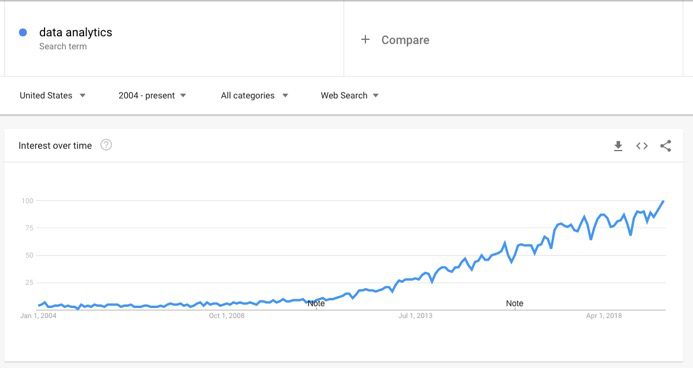We’d like to welcome Ron Friedmann, Chief Knowledge & Information Officer at LAC Group. Ron lends his perspective here on the ripe opportunity that data analytics presents for law firms that are looking to grow their business and drive profitability. We recently had the opportunity to sit down with Ron to talk about the impact data is having on the legal sector, which you can explore in this video. His commentary gives further context, a brief history, the applications and the impact that data is having on professional services. Please leave us a comment on Twitter of LinkedIn with your questions or further explorations of this theme you’d like to see.

By Ron Friedmann:
Imagine your firm wins more cases and gains new business regularly.
With data analytics, these and other benefits are rapidly becoming a reality.
Let’s start with some background. According to Forbes, almost 80% of enterprise executives say that not embracing big data will cause companies to lose competitive position and risk extinction. I could cite many more eye-catching stats about big data but let’s just agree that we now live in the age of data analytics. I explain here what data analytics is, how its age arrived, and what that means for the legal market.
What is data analytics?
Data analytics is the art, science, and statistics that help decision makers interpret large volumes of data to understand past trends, predict future ones, and make better informed decisions. Data analysis has a long and productive history. An old example is weather forecasting. Newer ones include recommendation engines (e.g., Amazon or Netflix) and voter targeting (multiple political campaigns).
A few big and recent trends explain why the age of data analytics has arrived: the rapid accumulation of data in all sectors of the economy, vastly increased and cheap cloud computing, more powerful algorithms, and much easier to use software. For a quick confirmation of the rise of interest in data analytics, see the Google Trend chart here showing the rapid ascent of it as a search term over the last five years.

The rise of data analytics in the legal market
The legal market lags many professional services and other sectors in adapting to and adopting big data and data analytics. In the last few years, however, we have seen many moves to address and accelerate that slow start. Examples include:
- The rise of pricing professionals and analysis in law firms (see recent trends on this in our latest Pricing for Client Advantage white paper), who rely on data for their craft. Even more noteworthy is the growing number of data scientists. (Download an Intapp and LawVision survey on data scientists in firms)
- The growth of legal operations professionals in law departments who use data to help manage the legal function
- A multitude of new third-party products that tap public law to help analyze and predict outcomes in pending matters based on publicly available legal information
I have personally seen the rising importance of data analytics in attending three recent conferences. Two of these events were put on by ARK Group, a B2B publishing and events company serving the legal and information management markets. LAC Group was a sponsor of both events.
Competitive Intelligence in the Modern Law Firm was held on September 25th in New York City. This one-day conference focused on the need to elevate intelligence, with both internal and external data, to help firms understand who their competitors, how to position their expertise and offerings, and other marketing and business development imperatives.
One of those imperatives is to decide consciously how the information is published and delivered to decision-makers and groups that may have different needs and expectations. In a session I moderated, featuring three large law firm marketing executives, we discussed the CI lifecycle with a focus on delivery, from in-depth reports to highly condensed infographics and everything in between.
The high volume of data today can make traditional means of presenting information obsolete. I led a session on visual intelligence at the 2019 COLPM (College of Law Practice Management) Futures Conference (my preview blog post here). Most audiences prefer “pictures” over text or tables because humans evolved to absorb visual images rapidly. Consequently, presenting both data and results visually helps make data analytics more digestible and useful.
Finally, at ARK’s annual KM conference, Knowledge Management in the Legal Profession, data and data analytics permeated the two-day conference. KM has always been about capturing and leveraging a firm’s experience and intellectual capital as a strategic resource. By incorporating modern data analytics tools in the KM process, the Pareto Principle, which suggests that 20 percent of activities account for 80 percent of results, can be applied.
Data analytics will drive more consumption of external information
I expect the current trends in legal data analytics to continue. We have enough examples and data to see the benefit: more cost effective legal solutions, better predictive capabilities (that help reduce cost and make better decisions), more effective management of outside counsel, and more selective and likely to win pitches by law firms for new work.
Perhaps the most compelling example for law firms is in the pricing realm. In the last decade, many clients have demanded budgets and price certainty. Analyzing past matters has allowed many firms to meet these demands while maintaining their profitability. This and other early successes have whet the appetite of practicing lawyers—and encouraged a raft of both established companies and start-ups to offer new products and services.
External data helps drive better decision-making
Wearing my LAC Group hat, the angle that especially excites me is the likelihood that data analytics will drive rising demand for external information, specifically market and competitive intelligence. Legal service demand is stable, but essentially flat and increasingly more competitive. If firms rely only on internal data and experience, they miss the whole picture and end up making decisions in a vacuum. That hinders their ability to win new business and hang on to existing clients. External news, research and awareness reports, which LAC provides, are key to providing context and meaning to internal analytics. More specifically, we expect to see organizations incorporate more information about trends in industries, disciplines, clients, prospects, and competitors into their internal analytics.
If you are interested in the rise of data analytics, examples of uses, some of the challenges, and where it is heading, I encourage you to read some of my recent data oriented blogs. And once you do, we’d love to hear your views, which you can share with us on Twitter or LinkedIn. Please share with us your views on other data related topics you may want to delve into deeper next time.